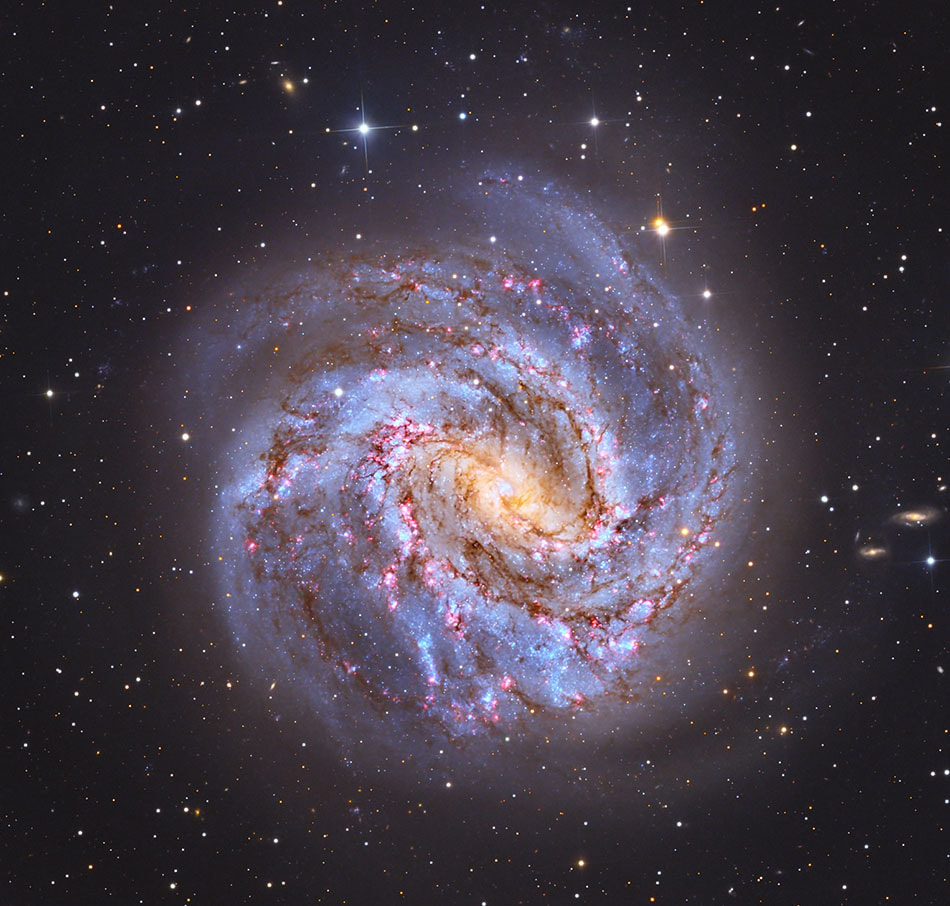Blog
Wilbert Thirkield “Big Chief” Ellis (November 10, 1914 – December 20, 1977)was an American blues pianist and vocalist.
Ellis was born in Birmingham, Alabama, United States, and was an autodidact at piano. He played at local parties and dances in the late 1920s before leaving Alabama, traveling the United States and working odd jobs. He served in the Army from 1939 to 1942, then moved to New York City, where he accompanied touring blues performers for their concerts there. He recorded with Lenox Records in 1945, and recorded for Capitol Records with Sonny Terry and Brownie McGhee in the 1950s.
In 1972, Ellis moved to Washington, D.C., where he operated a liquor store. Towards the end of his life, Ellis began recording for Trix Records, where he played again with McGhee as well as Tarheel Slim and John Cephas.
Ellis died in Birmingham, Alabama, of heart failure aged 63.
more...The largest canyon in the Solar System cuts a wide swath across the face of Mars. Named Valles Marineris, the grand valley extends over 3,000 kilometers long, spans as much as 600 kilometers across, and delves as much as 8 kilometers deep. By comparison, the Earth’s Grand Canyon in Arizona, USA is 800 kilometers long, 30 kilometers across, and 1.8 kilometers deep. The origin of the Valles Marineris remains unknown, although a leading hypothesis holds that it started as a crack billions of years ago as the planet cooled. Several geologic processes have been identified in the canyon. The featured mosaic was created from over 100 images of Mars taken by Viking Orbiters in the 1970s. 88 million miles.

more...
Sir Timothy Miles Bindon Rice (born 10 November 1944) is an English lyricist and author. He is best known for his collaborations with Andrew Lloyd Webber, with whom he wrote, among other shows, Joseph and the Amazing Technicolor Dreamcoat, Jesus Christ Superstar, and Evita; Chess (with Björn Ulvaeus and Benny Andersson of ABBA); Aida (with Elton John); and, for Disney, Aladdin (with Alan Menken), The Lion King (with John), both the stage adaptation of Beauty and the Beast and the live-action film adaption (with Menken). He also wrote lyrics for the Alan Menken musical King David, and for DreamWorks Animation‘s The Road to El Dorado (with John).
Rice was knighted by Elizabeth II for services to music in 1994. He has a star on the Hollywood Walk of Fame, is a 1999 inductee into the Songwriters Hall of Fame and is the 2023 recipient of its Johnny Mercer Award, is a Disney Legend recipient, and is a fellow of the British Academy of Songwriters, Composers, and Authors. In addition to his awards in the UK, he is one of twenty-one artists to have won an Emmy, Oscar, Grammy and Tony in the US.
Rice twice hosted the Brit Awards (in 1983 and 1984). The 2020 Sunday Times Rich List values Rice’s wealth at £155m; the 21st-richest music millionaire in the UK.
more...Russell Charles Means (November 10, 1939 – October 22, 2012) was an Oglala Lakota activist for the rights of American Indians and all oppressed First Nation Americans, libertarian political activist, actor, musician and writer. He became a prominent member of the American Indian Movement (AIM) after joining the organization in 1968 and helped organize notable events that attracted national and international media coverage.
Means was active in international issues of indigenous peoples, including working with groups in Central and South America and with the United Nations for recognition of their rights. He was active in politics at his native Pine Ridge Indian Reservation and at the state and national level.
Beginning an acting career in 1992, he appeared on numerous television series and in several films, including The Last of the Mohicans and Pocahontas and released his own music CD. Means published his autobiography Where White Men Fear to Tread in 1995.
more...Bobby Rush (born Emmett Ellis Jr. in Homer, Louisiana on November 10, 1933) is an American blues musician, composer, and singer. His style incorporates elements of blues, rap, and funk, as well as a comic sense about blues tropes.
Rush has won twelve Blues Music Awards and in 2017, at the age of 83, he won his first Grammy Award for the album Porcupine Meat. He is inducted into the Blues Hall of Fame, Mississippi Musicians Hall of Fame, and Rhythm & Blues Music Hall of Fame.
more...Hubert Laws (born November 10, 1939) is an American flutist and saxophonist with a career spanning over 50 years in jazz, classical, and other music genres. Laws is one of the few classical artists who has also mastered jazz, pop, and rhythm-and-blues genres, moving effortlessly from one repertory to another. He has three Grammy nominations.
more...Paul Bley, CM (November 10, 1932 – January 3, 2016) was a Canadian jazz pianist known for his contributions to the free jazz movement of the 1960s as well as his innovations and influence on trio playing and his early live performance on the Moogand ARP synthesizers. His music has been described by Ben Ratliff of the New York Times as “deeply original and aesthetically aggressive”. Bley’s prolific output includes influential recordings from the 1950s through to his solo piano recordings of the 2000s.
more...Andrew Charles Cyrille (born November 10, 1939) is an American avant-garde jazzdrummer. Throughout his career, he has performed both as a leader and a sideman in the bands of Walt Dickerson and Cecil Taylor, among others. AllMusic biographer Chris Kelsey wrote: “Few free-jazz drummers play with a tenth of Cyrille’s grace and authority. His energy is unflagging, his power absolute, tempered only by an ever-present sense of propriety.”
Cyrille was born in Brooklyn, New York, United States, into a Haitian family. He began studying science at St. John’s University, but was already playing jazz in the evenings and switched his studies to the Juilliard School. His first drum teachers were fellow Brooklyn-based drummers Willie Jones and Lenny McBrowne; through them, Cyrille met Max Roach. Nonetheless, Cyrille became a disciple of Philly Joe Jones.
more...Messier 83 or M83, also known as the Southern Pinwheel Galaxy and NGC 5236, is a barred spiral galaxy approximately 15 million light-years away in the constellationborders of Hydra and Centaurus. Nicolas-Louis de Lacaille discovered M83 on 17 February 1752 at the Cape of Good Hope. Charles Messier added it to his catalogue of nebulous objects (now known as the Messier Catalogue) in March 1781. 14.7ly distant.

Mary Allin Travers (November 9, 1936 – September 16, 2009 Louisville, KY) was an American singer-songwriter who found fame as a member of the 1960s folk trio Peter, Paul and Mary, along with Peter Yarrow and Paul Stookey. Travers grew up amid the burgeoning folk scene in New York City‘s Greenwich Village, and she released five solo albums. She sang in the contralto range.
more...Solomon Kamaluhiakekipikealiʻikaʻapunikukealaokamahanahana Bright Sr. (9 November 1909 – 27 April 1992) was an entertainer of Hawaiian and Castilian ancestry, who played steel guitar and is most widely known as the composer of Hawaiian Cowboy. He was born one of fourteen children to Hawaiian minister Andrew Laukea Bright and church organist Alike Kekipau Bright in Honolulu.
His early touring years were as part of Sol Hoʻopiʻi‘s Novelty Trio, before forming Sol K. Bright’s Hollywaiians. During this time, Bright also began producing musical shows. After his World War II stint in the U.S. Merchant Marines, he began appearing in films and on radio and television. In his later years he performed regularly in Hawaii before live audiences.
more...Milton Mesirow (November 9, 1899 – August 5, 1972), better known as Mezz Mezzrow, was an American jazz clarinetist and saxophonist from Chicago, Illinois. He is remembered for organizing and financing recording sessions with Tommy Ladnier and Sidney Bechet. He recorded with Bechet as well and briefly acted as manager for Louis Armstrong. Mezzrow is equally known as a colorful character, as portrayed in his autobiography, Really the Blues (which takes its title from a Bechet composition), co-written with Bernard Wolfe and published in 1946.
According to one biographer: “As a juvenile delinquent, [Mezzrow] was in and out of reformatory schools and prisons where he was exposed to jazz and blues music. He began to play the clarinet and decided to adopt the African American culture as his own. He became a ubiquitous figure on the Chicago jazz scene of the 1920s and ran in the circles of musicians that included King Oliver, Louis Armstrong, Sidney Bechet, Jimmy Noone, Al Jolson, Baby Dodds, Bix Beiderbecke, Louis Bellson and many others. [He] was an advocate for the pure New Orleans jazz style.”
more...Kenny Cox (November 8, 1940 – December 19, 2008) was a jazz pianist performing in the post bop, hard bop and bebop mediums. Cox was pianist for singer Etta Jonesduring the 1960s and was also a member of a quintet led by trombonist George Bohannon. By the end of the late 1960s he had formed his own Kenny Cox and the Contemporary Jazz Quintet, which recorded two albums for Blue Note Records before the end of the decade. Cox has appeared as a contributor on various albums, and has also performed live with such musicians as Rahsaan Roland Kirk, Eddie Harris, Jackie McLean, Roy Haynes, Ben Webster, Wes Montgomery, Kenny Dorham, Philly Joe Jones, Kenny Burrell, Donald Byrd, Roy Brooks, Charles McPherson, and Curtis Fuller. During the 1980s he formed the Detroit-based Guerilla Jam Band, a group which performed with Regina Carter, James Carter, Tani Tabbal, Jaribu Shahid, Ralph Miles Jones, Marc Silver, and Craig Taborn. Cox was responsible for the short-lived Strata Records.
He died in his Detroit home of lung cancer at the age of 68.
more...More Posts
- Joe Henderson
- Johnny Griffin
- STOP WAR IN UKRAINE World Music Jozef Rybár, Ján Berky, Švihrovská
- Daily Roots Twinkle Brothers
- Cosmos Waterspout
- Roy Orbison
- Bunky Green
- Cow Cow Davenport
- World Music Firas Zreik
- Daily Roots Prince Far I
- Happy Earth Day 2023
- Cosmos NGC 1333
- Rajae Belmlih
- Jack Nitzsche
- Paul Chambers
- Charles Mingus
- SAVE UKRAINE World Music RULADA
- Daily Roots Leroy Smart
- Shabbat for the Soul at Mt Zion
- Cosmos NGC 2174


